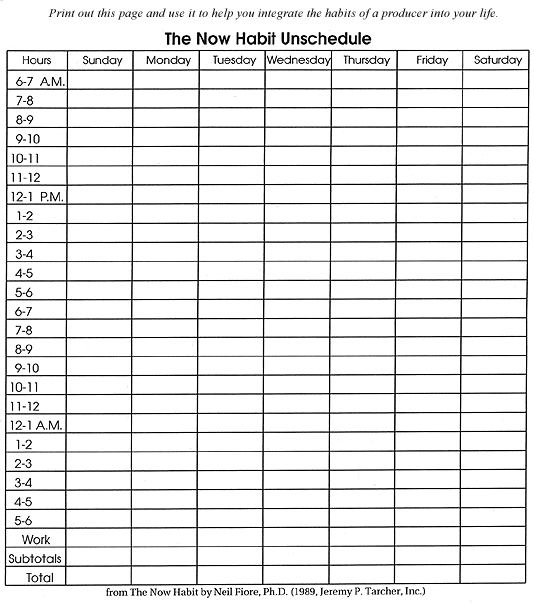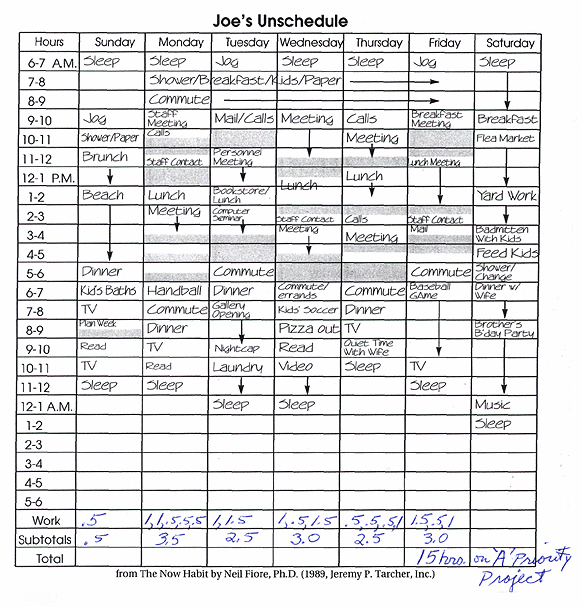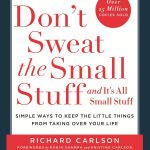Print | Kindle(eBook) | Audiobook
In his illuminating book The Now Habit: A Strategic Program for Overcoming Procrastination and Enjoying Guilt-Free Play, Psychologist and Author Dr. Neil Fiore write about a time-planning/management tool he called “The Unschedule.” I found the tool to effectively deal with procrastination, re-ordering your priorities, and getting things done.
The Unschedule is a weekly calender of committed recreational activities that divides the week into manageable pieces with breaks, meals, scheduled socializing, and play. In addition, it’s a record of your productive, uninterrupted work. It provides producers with a prescheduled commitment to guilt-free time for recreation, plus a realistic look at the actual time available for work.
This method of scheduling encourages you to start earlier on your project because you now realize how little time is actually available for work after you deduct daily chores, meetings, commuting, meals, sleep, and leisure. In addition, starting is easier because thirty minutes of work is too little to be intimidating, while it is enough to make a good start and to receive a break or reward. Thirty minutes reduces work to small, manageable, rewardable chunks that lessen the likelihood that you will feel overwhelmed by the complexity and length of large or menacing projects.

HOW TO USE THE UNSCHEDULE
Dr. Fiore profers eleven Unschedule guidelines:
1. Schedule only:
• previously committed time such as meals, sleep, meetings
• free time, recreation, leisure reading
• socializing, lunches and dinners with friends
• health activities such as swimming, running, tennis, working out at the gym
• routine structured events such as commuting time, classes, medical appointments
“It is basic to the principles of unscheduling that first you fill in your Unschedule with as many nonwork activities as possible. This will help you overcome the fantasy that you have twenty-four hours a day and forty-eight hours on the weekends to work on your projects. It will sharpen your perception of the actual time available and make you a better manager of your time.
Do not schedule work on projects. Remember, first and foremost, that the Unschedule guarantees your guilt-free play and the legitimacy of your personal time. This first step will help you avoid scaring yourself with overly ambitious, overly dictatorial plans for work that lead only to failure, disappointment, self-criticism, and procrastination.”
2. Fill in your Unschedule with work on projects only after you have completed at least one-half hour.
Think of the Unschedule as a time clock that you punch in as you start work and punch out when you take credit for your progress. You want to maintain an excitement about how much you’ve accomplished in a short period of time rather than anxiety about how much more there is to do. You can also use your thirty-minute commitment as your own deadline to motivate you to work more efficiently.
3. Take credit only for periods of work that represent at least thirty minutes of uninterrupted work.
Do not record the time on your Unschedule if you stop before thirty minutes are up. The discipline of staying with the task through the first few minutes of potential distractions and inertia is necessary to carry you through to involvement and interest in your work. When you stay with the discipline of uninterrupted work, you really know that the half hour you earned on your Unschedule represents quality work, not trips to get potato chips or to make calls. This mounting achievement will build your pride and confidence in yourself as a producer.
4. Reward yourself with a break or a change to a more enjoyable task after each period worked.
You deserve it. You got started! And by overcoming inertia, you have begun to build momentum that will make it easier to get started next time. By rewarding yourself this way for each positive achievement, you are creating positive associations with your work instead of negative ones. You are now in charge of creating a new and better habit—the Now Habit.
5. Keep track of the number of quality hours worked each day and each week.
Total them up. Emphasize what you did accomplish. This is rewarding in itself and establishes a positive pattern by following work with a pat on the back. It also alerts you to those days—for example, Wednesdays—when you will want to start earlier on your high-priority projects to increase the number of hours worked in a particular day.
6. Always leave at least one full day a week for recreation and any small chores you wish to take care of.
Avoid the feeling of resentment and the burnout that can come when there are no holidays because of work. Include family rituals of recreation and play in each week. You will feel more motivated to return to your high-priority projects after resting. Work will be less of a burden when you are experiencing the better parts of life now, and your life is not on hold because of work. Take time for yourself and those low-priority chores that you might actually enjoy as a change of pace—repairs around the house, gardening, or letters that you’ve put off writing. This day is essential for rejuvenation and maintaining creativity and motivation.
7. Before deciding to go to a recreational activity or social commitment, take time out for just thirty minutes of work on your project.
Any pleasurable or frequent activity you engage in has the power to create motivation for the activity it follows. By using this “Grandma’s Principle”—you get your ice cream only after you eat your spinach—you can get started with less pain and foster the building of good habits.
8. Focus on starting.
Your task is to get to the starting place on time. The advantage of this is that your “to do” list needs only one top priority item—“When is the next time I can start?” Replace all thoughts about finishing with thoughts about when, where, and on what you can start.
9. Think small.
Do not aim to finish a book, write letters, complete your income tax, or to work continuously for even four hours. Aim for thirty minutes of quality, focused work.
10. Keep starting.
Finishing will take care of itself. When it is time to start the last thirty minutes that will finish the project, that too will be an act of starting—the start of the conclusion of your current project, as well as the beginning of your next. So forget about finishing. If you must worry, worry about starting. In order to finish, all you have to do is to just keep starting!
11. Never end “down.
That is, never stop work when you’re blocked or at the end of a section. Remember “Grandma’s Principle”: to create good habits your breaks and treats must follow some work. No treats until you face what you’ve been avoiding. Never take a break (a reward) when you’re at the end of a segment or when you’re ready to give up.
Always stay with a tough spot for another five or ten minutes, trying to come up with at least a partial solution that you can pursue later. Remain open and curious about how your mind will rapidly and creatively solve the problem. You’ll find that staying with a difficulty for a few more moments is often enough for your brain to creatively resolve it. Gently pushing through a block or starting on the next section before you quit creates positive momentum, making it much easier to get started next time, thus eliminating the need to procrastinate.
All the Best in your quest to get Better. Don’t Settle: Live with Passion.
Order on Amazon: Print | Kindle(eBook) | Audiobook



1 Comment
Pingback: Book Summary – The Now Habit: A Strategic Program for Overcoming Procrastination and Enjoying Guilt-Free Play by Neil Fiore. – Lanre Dahunsi